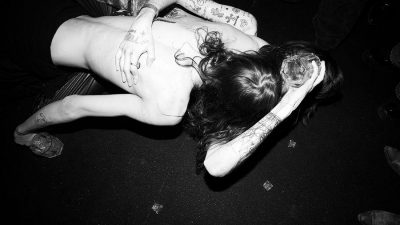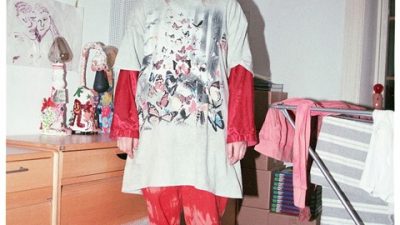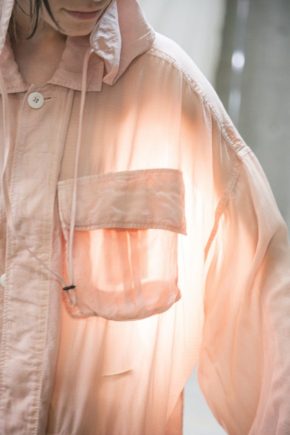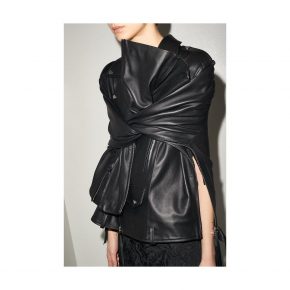Fujiki, who works as the PR manager for WAREHOUSE, was just hitting adolescence when the brand was established in Osaka in 1995 during the height of the vintage trend. Naturally, vintage became synonymous with fashion, and ever since he was completely committed to vintage styles. His stance remains unchanged from when he first joined WAREHOUSE, and in order to research the details of how things are made he discovered various books and old catalogs on a daily basis and totally immersed himself into the history of vintage fashion. This is how he acquired such a vast amount of knowledge and knowhow. When reproducing vintage items, WAREHOUSE has always had a policy of only reproducing items that they could actually hold in their hands since the brand was founded to this day. That is the level of commitment and passion that they have towards their craft. Traveling throughout Japan and overseas to various vintage dealers and shops in search of new items, their research continues on a daily basis. By reproducing items after extensive research of the materials and manufacturing methods they are able to create high quality products that age beautifully in the same way that authentic vintage items do. However, this level of commitment and attention to detail is difficult to understand if you’re not a true vintage fan. And it’s Fujiki’s job to explain why it is what they do and to spread it throughout the world. He fulfills his role as the PR manager by showcasing the aging process of the brand’s items that he wears on a daily basis. Put simply, “seeing is believing”.

His orthodox style while incorporating trendy items is a modern Tokyo “American casual” style. He always makes sure to include one or two vintage items along with garments made by WAREHOUSE to help promote the appeal of the brand.
Pairing a jacket from Heller’s Café and slim jeans from Brown-Duck&Digger, Fujiki shows off an outdoorsy style. The outfit is completed with a pair of Herman riding boots from the 1950s that he purchased recently with a knit cap with a GE patch from the 1970s.
Masaki Fujiki’s Profile:
Born in Kyoto in 1974. Having grown up as a huge fan of baseball, he still enjoys playing baseball as much as he loves vintage wear. He is known throughout the industry for his vast knowledge of denim workwear, which is synonymous with WAREHOUSE, as well as sportswear.

Pictured in front is an OMEGA Speedmaster from 1969 to the early 1970s. The extremely rare watch, standard equipped with a pulsometer scale, was given to him as a gift. The watch on the far end is a TUDOR Submariner from 1974. This watch is commonly referred to as the “Ika-sabu” (meaning squid sub) because its design resembles a squid.
The rusted steel buttons and the texture of the aged sulfide dyed denim create an amazing vintage-like look. This item was created by WAREHOUSE soon after the brand was founded.
Using deerskin for the body, mouton for the inner lining and horsehide for the pocket sides, this WAREHOUSE jacket was reproduced from a sports jacket made during the 1930s.
This beautifully glossy and aged horsehide jacket features patch pockets and was reproduced by WAREHOUSE from a jacket made during the 1930s.
This piece was reproduced by WAREHOUSE from an unbleached coverall that was originally made during the 1930s. With its perfectly cropped sizing, it can be coordinated with a wide range of outfits.
This denim jacket was artistically faded using Fujiki’s own technique of soaking it in a bathtub.
Pictured on the right is a pair of vintage glasses made by CUTLER AND GROSS. The thin frame of these glasses is especially stylish.
Pictured on the left is a silver bangle made by Navajo artist Ray Adakai.
All of the items pictured are Billiken good luck charms. Pictured on the left is a piece made with ivory from the 1950s. Next to that is a silver piece from the 1930s. On the right is an ice cream-shaped piece from the 1930s.
These vintage-style sweatshirts from WAREHOUSE have a beautiful faded look and appear almost identical to their original vintage models.
Two more vintage-style double-face parka. Pictured on the left is separate pocket parka with a retrofit hood from Heller’s Café. Pictured on the right is the snap-button hooded parka from WAREHOUSE.
Both of these shirts are made by WAREHOUSE, but the one pictured on the right is a rare cotton and linen work shirt. The original piece was manufactured during the 1940s. Pictured on the left is a shirt that was reproduced from a denim Western shirt made during the 1950s to the 1960s.
The flannel shirt is one of WAREHOUSE’s most popular items. Everything from the colorways to the texture resembles an authentic vintage look.
A newspaper bag from Heller’s Café. The cotton canvas fabric fades beautifully the more it is used, and is one of Fujiki’s personal favorites.
A triple collaborative retro Osaka Tigers uniform developed the by Hanshin Tigers, EBBETS FIELD, and WAREHOUSE. This uniform will be released as part of their new spring collection.

The Lot.1001 by WAREHOUSE features beautifully aged fading. The deep colorway and texture resembles that of the original item manufactured between the 1940s to the 1950s, and truly showcases the true value of the brand.
A pair of two-tone lace‐up boots made by WAREHOUSE. Using rugged soles from Vibram, these boots can be worn in a wide range of scenes, from the city to the great outdoors.
A pair of raw WAREHOUSE’s Lot.1001 denim from over 15 years ago aged beautifully over years of wear by Fujiki himself.
Adding a sporty look to a chic outfit transforms the look into a more modern style. This outfit consists of a yard coat by Heller’s Café, a special custom order Gansey knit sweater from WAREHOUSE, and a pair of French army pants from the 1940s. The cap is from a previous collaboration between KIJIMA TAKAYUKI and WAREHOUSE.
WAREHOUSE
1-29-8 1F EBISU WEST EBISUNISHI SHIBUYAKU TOKYO
Tel.03-5457-7899
11AM~8PM














































Comments